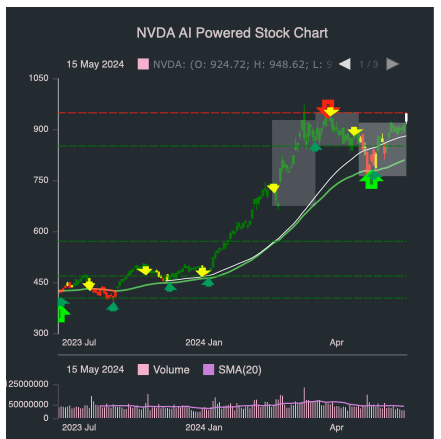AI trading platforms that predict/analyze stocks are renowned for their capacity to modify strategies that meet the demands of the users. This lets them adapt to specific trading goals and conditions, such as the risk tolerance. Platforms with powerful customization features will increase the efficiency of your trading. Here are the best 10 ways to assess the capability of platforms to modify their strategies:
1. Evaluate Pre-Built Strategy Templates
A Variety of Templates: Check whether the platform you are using provides templates that are pre-built for various trading styles (e.g. Day Trading and Swing Trading, as well as Long-Term Investment).
The user's experience is a good indication.
Performance history: Verify that the platform contains previous data on performance that can be used to create pre-built strategic plans.
2. Assessment Custom Strategy
Drag-and-drop tools: Find platforms that offer intuitive drag-and-drop interfaces to design customized strategies.
Check the platform's coding options. Advanced users may want to utilize custom scripting language (e.g. Python or R).
Flexibility: Ensure that the platform allows you to define entry and exit rules and risk management guidelines, and other essential elements of your plan.
3. Check for Backtesting Capabilities
Historical data: Make sure that the platform provides sufficient historical data to test your strategies.
Customizable parameters - Ensure that you are able to alter parameters (e.g. timeframes, indicator) while testing backtests.
Performance metrics: Ensure that the platform provides detailed metrics of performance (e.g. Win rate Sharpe Ratio, Drawdown) in the back-testing of strategies.
4. Evaluate Real-Time Strategy Testing
Simulation or paper trading Check that the platform supports paper trading modes that allow you to try out trading strategies in real time and without putting your money at risk.
Live testing: Check whether you are able to run strategies live in markets using tiny amounts of capital to assess their performance.
Real-time Adjustments: Determine whether you can make adjustments in real-time according to the market's conditions.
5. Integrate integration with technical indicators
Verify if there's an indicator library.
Custom indicators - Make sure you can build or import your own custom indicators.
Check if you can combine several indicators to make more complex strategies.
6. Check for Risk Management Tools
Stop-loss/take-profit: Ensure the platform allows you to set stop-loss and take-profit levels within your strategies.
Size of your position. Make sure you have rules in place for how to manage your risk (e.g. set amount per portfolio, percentage).
Risk-reward rate: Verify whether the platform allows setting risk-reward rates specific to strategies or individual trades.
7. Evaluate Multi-Asset Strategy Support
Asset classes: Make sure that the platform can help strategies across multiple asset categories (e.g. stocks, ETFs or options or forex).
Cross-assets strategies: Discover whether you're capable of designing strategies that combine multiple asset classes.
Market coverage. Verify whether the platform has market coverage that you're interested in (e.g. US international, copyright).
8. Evaluate Automation and Execution
Automated trading. Make sure the platform supports automated execution that is based on predefined strategies.
Types of orders: Check to see if the system allows for different order types (e.g. limit, market) when executing a strategy.
Latency Check: Ensure that the platform permits transactions to be completed with minimal latency. This is crucial when it comes to high-frequency strategy.
9. Look for strategies optimization tools
Parameter Optimization: Check whether the platform provides tools to optimize the parameters of strategies (e.g. genetic algorithms, grid search).
Machine learning integration: Determine whether the platform is using machine learning for refinement and improvement of strategies.
Scenario analysis: Verify whether the platform permits testing strategies in different market conditions (e.g., bear, bull and volatile).
Review Community Support and User Feedback
Feedback from users: Conduct user research to evaluate the effectiveness of the platform for creating a custom strategy.
Community forums. Check if users are able to share information and discuss their ideas within a lively and vibrant community.
Support resources. Be sure to check for tutorials or webinars to assist you in developing and optimizing your strategies.
Bonus Tips:
Trial period: Try the customisation capabilities of the platform with a free demo or trial.
Scalability: Your platform should be able to support ever more complicated trading strategies as you evolve.
Customer support: Verify whether the platform has support for any strategy-related questions.
Follow these tips to assess the AI platform's stock prediction/analyzing capabilities and capability to modify strategies. By doing so you can ensure you select a platform which aligns with your goals for trading and allows you create and improve your personal strategies. A platform that offers many customization options can help you better adapt to market changes and boost your trading performance. View the recommended read this on ai stock trading for site advice including ai investing app, ai investing app, best ai stock, chart ai trading assistant, ai stock trading app, best ai for trading, ai trading, incite, ai stock market, best ai trading app and more.

Top 10 Tips For Evaluating The Effectiveness Of Ai Stock Predicting/Analyzing Trading Platforms
To ensure AI-driven stock trading and prediction platforms are scalable and scalable, they need to be able to deal with the increasing volume of data and complexity in markets, and also customer demands. Here are 10 top tips for evaluating the scalability.
1. Evaluate Data Handling Capacity
TIP: Find out if the platform is able to analyse and process large data sets (e.g., historical stock data, live market feeds, and alternative data such as news or social media).
The reason: Scalable platforms must be able to be able to handle growing volumes of data without performance degradation.
2. Test Real-Time Processor Capabilities
Try the platform out to see how it handles streams of data in real-time, such as breaking news or live price updates.
Reason the trading decision is made in real-time. Delays could cause traders to miss out on opportunities.
3. Check Cloud Infrastructure and Elasticity
Tips: Determine whether the platform is able to dynamically scale resources, and if it uses cloud infrastructure (e.g. AWS Cloud, Google Cloud, Azure).
Why: Cloud-based platforms provide elasticity. They permit the system to be scaled down according to the need.
4. Assess Algorithm Efficiency
Tip 1: Analyze the computational performance of the AI models used (e.g. reinforcement learning deep learning).
The reason: Complex algorithms can consume a lot of resources. Optimising them is essential to scale them.
5. Examine Distributed and Parallel Computing
Make sure that your platform supports parallel processing or distributed computing (e.g. Apache Spark, Hadoop).
What is the reason? They can accelerate data processing across multiple nodes.
6. Examine API Integration and Interoperability
TIP Try to test the platform's capacity to integrate with external APIs (e.g. brokerage APIs, market data providers APIs).
Why? Seamless integration allows the platform to adapt to changing trading environments and data sources.
7. Analyze User Load Handling
Tip: Simulate the impact of high user traffic to test how the platform does under pressure.
The reason is that a platform that can scale should be able to keep up with its performance as the number of users increase.
8. Analyze the model retraining and the model's adaptability
Tips: Examine how often and effectively AI models are trained by new data.
The reason is that markets change and models must adapt quickly to ensure the accuracy.
9. Check for Fault Tolerance & Redundancy
TIP: Make sure the platform is equipped with failover mechanisms and redundant systems in the event of software or hardware failures.
Why? Downtime in trading can be expensive, and fault tolerence is important to allow for the scalability.
10. Monitor Cost Efficiency
Review the costs involved in scaling up the platform. This includes cloud resources as well as data storage, as well as computational power.
What is the reason? Scalability shouldn't be at the expense of insufferable costs. It is therefore important to strike a fair balance between performance and cost.
Bonus Tip: Future-Proofing
Ensure the platform is built to take advantage of new technologies (e.g. quantum computing, quantum computing and advanced NLP) and be able to adjust to changes in the regulatory environment.
If you concentrate your attention on these elements, you can accurately assess the scale of AI prediction as well as trading platforms. This ensures that they are durable and efficient and prepared for growth. See the most popular ai stock investing hints for blog info including how to use ai for copyright trading, ai in stock market, ai software stocks, best ai stocks, free ai stock picker, ai for trading stocks, ai stock trader, best ai for stock trading, best ai stock prediction, chart analysis ai and more.
